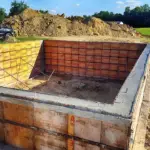So, how do you calculate concrete mix ratio?
When you’re involved in construction, determining the right amount of building materials is essential be it pcc mix ratio, or lean mix concrete. In case of concrete, the quantities are determined by the mix proportions or the mix design.
So, let’s delve into concrete mix calculations for different concrete mix ratios using the dry mix method.
We’ll calculate the quantities for 1 cubic meter (m³) of concrete by volume.
Also Read: How to calculate cement sand and aggregate quantity in M15 concrete?

Concrete Mix Calculations
To determine the materials needed for concrete, like cement, sand, and aggregates, for specific mix proportions such as 1:2:4 (M15), 1:1.5:3 (M20), 1:1:2 (M25), we use the absolute volume method.
This method relies on the idea that the fully compacted concrete’s volume equals the absolute volume of all its components: cement, sand, coarse aggregates, and water.
For concrete structures comprising beams, slabs, columns, and foundations, the total concrete volume is calculated by adding up the volumes of each structural part or component.
For a rectangular cross-sectional member, you can find its volume using the formula: length x width x height (or depth or thickness).
Like Us on Facebook!
Different formulas apply to various cross-sectional shapes.
Subscribe Us on YouTube!
Concrete Mix Formula
The formula for calculating materials for a required concrete volume is as follows:
Vc = Absolute volume of fully compacted fresh concrete
W = Mass of water
C = Mass of cement
Fa = Mass of fine aggregates
Ca = Mass of coarse aggregates
Sc, Sfa, and Sca are the specific gravities of cement, fine aggregates, and coarse aggregates, respectively. This calculation does not consider air content. It’s based on design mix or nominal mixes to meet structural strength and durability requirements.
Now, let’s illustrate material calculations with an example.
Assuming the concrete mix ratio by volume proportion as 1:2:4 (Cement: Sand: Stone = a:b:c)
For wet concrete volume = 1 m³
For dry concrete volume = 1 × 1.54 = 1.54 m³
But what is 1.54, you ask? It’s the dry factor that convert wet volume into dry volume.
Mix Calculation for Cement:
Cement = (Volume of dry concrete/a+b+c) × a
= (1.54/a+b+c) × a = [(1.54/1+2+4)] × 1 = 0.22 cubic meters
Now, cement density = 1440 kg/cu.m
So, volume of cement = 0.22 × 1440 = 316.8 kg.
Considering 1 bag of cement contains 50 kg,
Cement bags required = 316.8/50 = 6.33 bags.
Calculation for Sand
Sand = (Volume of dry concrete/a+b+c) × b
= (1.54/a+b+c) × b = (1.54/1+2+4) × 2 = 0.44 cubic meters.
Calculation for Aggregates
Aggregates = (Volume of dry concrete/a+b+c) × c
= (1.54/a+b+c) × c = (1.54/1+2+4) × 4 = 0.88 cubic meters.
Also Read: Concrete aggregate calculator
Calculation for Water Content
Let’s assume the water-cement ratio of concrete is 0.45.
w/c = 0.45
Required water for 1 bag cement = 0.45 × 0.0353 = 0.0159 cubic meters.
Where the volume of 50 kg cement = 0.0353 cubic meters
1 m³ water = 1000 liters
So, required water for 1 bag of cement = 0.0159 × 1000 = 15.9 liters.
Hence, required water for 6.33 bags of cement = 6.33 × 15.9 = 101 liters.
In Summary:
- Cement = 6.33 bags
- Sand = 0.44 cubic meters
- Aggregates = 0.88 cubic meters
- Water = 101 liters
Note: Concrete yield is considered as 67%, and material wastage is estimated at 2%.
You can apply the same formula for various mix proportions like 1:1.5:3, etc.
We’ve used cubic meters as the unit, but you can also perform calculations in cubic feet.
Quantities in per cubic meter or cubic feet or cubic yards concrete
Let’s consider a concrete mix with proportions 1:1.5:3, where 1 part is cement, 1.5 parts are fine aggregates, and 3 parts are coarse aggregates (max size: 20mm). The water-cement ratio is set at 0.45.
For bulk densities of materials per cubic meter, cubic feet, and cubic yards:
- Cement: 1500 kg/m³ = 93.642 lb/ft³ = 2528.332 lb/cubic yards
- Sand: 1700 kg/m³ = 105 lb/ft³ = 2865.443 lb/cubic yards
- Coarse aggregates: 1650 kg/m³ = 103 lb/ft³ = 2781.166 lb/cubic yards
Specific gravities of materials:
- Cement: 3.15
- Sand: 2.6
- Coarse aggregates: 2.6
We assume an entrained air percentage of 2%. The dry volume mix proportion of 1:1.5:3 translates into masses as follows:
- Cement: 1 x 1500 = 1500
- Sand: 1.5 x 1700 = 2550
- Coarse aggregate: 3 x 1650 = 4950
Hence, the mass ratios relative to cement are: Ratio of masses: 1 : 1.7 : 3.3
With one bag of 50 kg cement, we calculate the concrete volume it can produce: Volume for 1 bag of cement = Volume of concrete for 50 kg cement For this mix proportion, one bag produces 0.1345 m³ of concrete. Factoring in 2% entrained air, the actual volume for 1 cubic meter of compacted concrete construction is 0.98 m³.
So, the cement quantity for 1 cubic meter of concrete = 0.98/0.1345 = 7.29 bags.
Material quantities for 1 m³ of concrete production:
- Cement required = 7.29 x 50 = 364.5 kg
- Fine aggregate (sand) = 1.5 x 364.5 = 546.75 kg
- Coarse aggregate = 3 x 364.5 = 1093.5 kg
Concrete Mix Ratio Calculator
Here’s the concrete mix calculator that help you pick a concrete mix design and using the formula as explained above, it will help you get the quantity of aggregate required, cement, sand, and water.






















